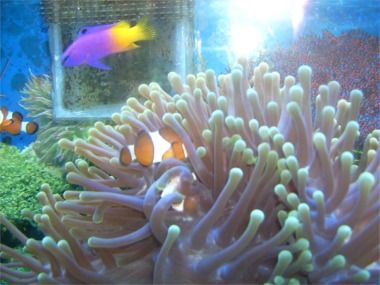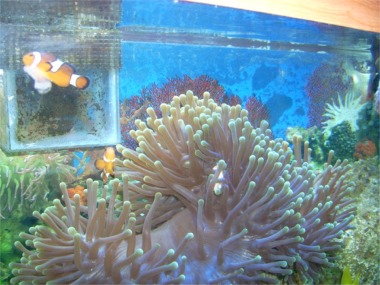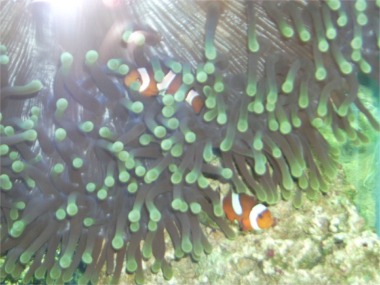|
|
||
|
Amphiprion ocellaris live in harmony with sea anemones of the species Heteractis magnifica or Stichodactyla gigantea. This particular relationship is a mutualism relationship because both species benefit from the interaction. The anemonefish help their host by providing nutrients in terms of nitrogenous wastes, while also grooming the anemone by eliminating it of parasites and debris. Clownfish also increase the water circulation within the anemone through the fanning action of their fins. In return for this help, the fish gains protection from predators for themselves and their clutches. Their clutches are often victimized at night by damselfish (Pomacentridea), wrasses (Labridae), and brittle stars (Ophiotrichidae. The host anemone also gains protection from predators through the aid of the anemonefish. One of the main anemone predators is the butterfly fish. Even though the clownfish is small compared to its host, it provides protection by being very territorial and chasing away any host predators. (See also Habitat and Nutrition). |
||
|
|
|
|
|
Amphiprion ocellaris are not known for interacting with many other species. In their host anemones, they can be found living with few species other than A. ocellaris. One species that they have been known to live around is the anemone shrimp (such as the Peridimenes holthuisi). Other than this species, the clownfish tend to stick to themselves. This reduces their rate of predation from others, but increases conflict within their host. If the population of Amphiprion ocellaris in a host becomes too large, the survival rate for the smaller fish decreases considerably. This makes it hard for new fish to enter into a host, unless there is “social space” within the anemone as a result of another fish dying. For more information, see Habitat. |
||
|
|
||
|
The Amphiprion ocellaris fish is one of the most common types of Amphiprion to be found in aquariums do to their high survival rate in saltwater tanks. This has increased their popularity among fish owners. As for human consumption, these fish are rarely eaten because they are so small. Therefore, Amphiprion ocellaris do not fall victims to human diets, but rather to human desires to have “tropical fish.” |
||


